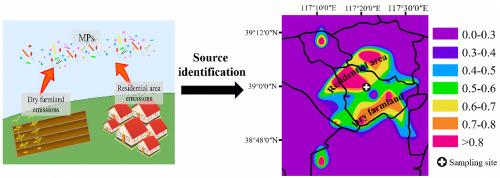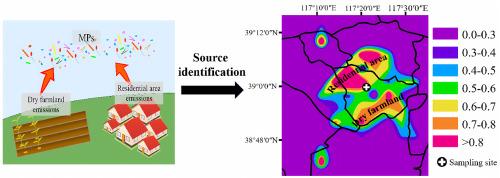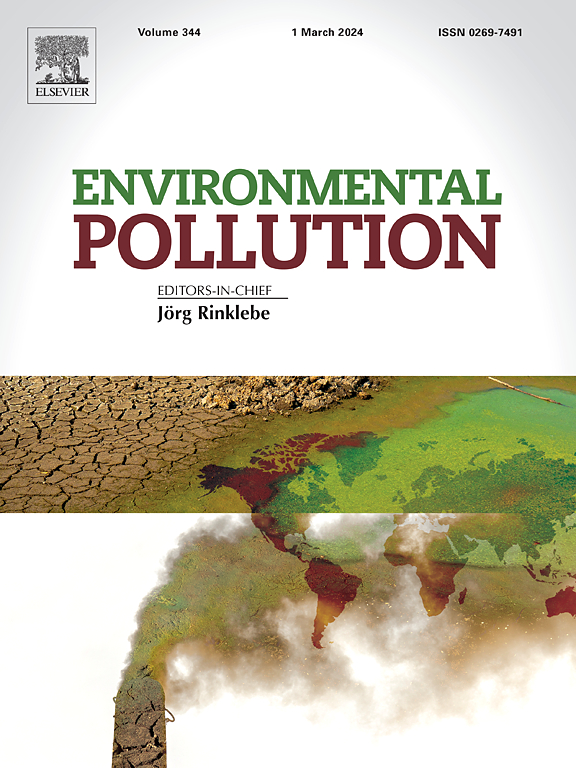Potential source contribution function coupled with mass spectrometry detection to identify source of atmospheric polyethylene terephthalate
IF 7.3
2区 环境科学与生态学
Q1 ENVIRONMENTAL SCIENCES
引用次数: 0
Abstract
Source identification of atmospheric microplastics (MPs) is crucial for the development of mitigation policies. Compared with wind directions or backward trajectories of air masses, the potential source contribution function (PSCF) analysis identifies more comprehensive sources of atmospheric particles. However, conducting PSCF analysis requires hourly pollutant concentration data, which cannot be met by the atmospheric MPs abundance obtained through commonly used methods. In this study, total suspended particles (TSP) samples were collected hourly and the concentrations of atmospheric polyethylene terephthalate (PET) were detected using a liquid chromatography-tandem mass spectrometry. Atmospheric concentrations of PET MPs were 112.9 ± 39.04 ng/m³ (average ± SD). Based on the hourly backward trajectories of air masses and the varied PET concentrations at the sampling site, potential sources of atmospheric PET were identified by PSCF analysis. The backward trajectory-based method indicates that atmospheric PET of the target site in this study primarily originates from dry farmlands. In comparison, both the residential areas and the dry farmlands were identified by PSCF as major sources of atmospheric PET at the receptor site. In contrast, both the backward-trajectory based method and PSCF analysis indicate that TSP mainly originates from the dry farmlands near the sampling site. This indicates that atmospheric PET in urban areas may have different sources from those of TSP, and PSCF is a suitable method for identifying sources of atmospheric PET.


潜在源贡献函数与质谱检测相结合,确定大气中的聚对苯二甲酸乙二酯来源
大气微塑料(MPs)的来源识别对于制定减缓政策至关重要。与风向或气团的后向轨迹相比,潜在源贡献函数(PSCF)分析可以识别更全面的大气颗粒物来源。然而,进行 PSCF 分析需要每小时的污染物浓度数据,而通过常用方法获得的大气 MPs 丰度无法满足这一要求。本研究每小时收集一次总悬浮颗粒物(TSP)样本,并使用液相色谱-串联质谱法检测大气中聚对苯二甲酸乙二醇酯(PET)的浓度。大气中的 PET MPs 浓度为 112.9 ± 39.04 纳克/立方米(平均值 ± 标差)。根据气团的每小时后向轨迹和采样点不同的 PET 浓度,通过 PSCF 分析确定了大气中 PET 的潜在来源。基于后向轨迹的方法表明,本研究中目标地点的大气 PET 主要来自干旱农田。相比之下,PSCF 将居民区和干旱农田都确定为受体地点大气 PET 的主要来源。相比之下,基于后向轨迹的方法和 PSCF 分析都表明,TSP 主要来自采样点附近的干旱农田。这表明,城市地区大气 PET 的来源可能与 TSP 的来源不同,而 PSCF 是确定大气 PET 来源的合适方法。
本文章由计算机程序翻译,如有差异,请以英文原文为准。
求助全文
约1分钟内获得全文
求助全文
来源期刊

Environmental Pollution
环境科学-环境科学
CiteScore
16.00
自引率
6.70%
发文量
2082
审稿时长
2.9 months
期刊介绍:
Environmental Pollution is an international peer-reviewed journal that publishes high-quality research papers and review articles covering all aspects of environmental pollution and its impacts on ecosystems and human health.
Subject areas include, but are not limited to:
• Sources and occurrences of pollutants that are clearly defined and measured in environmental compartments, food and food-related items, and human bodies;
• Interlinks between contaminant exposure and biological, ecological, and human health effects, including those of climate change;
• Contaminants of emerging concerns (including but not limited to antibiotic resistant microorganisms or genes, microplastics/nanoplastics, electronic wastes, light, and noise) and/or their biological, ecological, or human health effects;
• Laboratory and field studies on the remediation/mitigation of environmental pollution via new techniques and with clear links to biological, ecological, or human health effects;
• Modeling of pollution processes, patterns, or trends that is of clear environmental and/or human health interest;
• New techniques that measure and examine environmental occurrences, transport, behavior, and effects of pollutants within the environment or the laboratory, provided that they can be clearly used to address problems within regional or global environmental compartments.
 求助内容:
求助内容: 应助结果提醒方式:
应助结果提醒方式:


